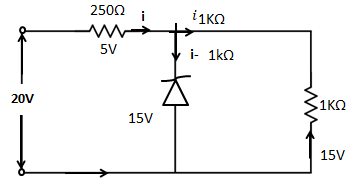
A Zener diode, having breakdown voltage equal to \[15V\] is used in a voltage regulator circuit shown in figure. The current through the diode is:

A) $10mA$
B) $15mA$
C) $20mA$
D) $5mA$
Answer
146.7k+ views
Hint: Zener diode is a semiconductor diode in which a critical reverse voltage a large reverse current can flow. Zener diode is like a normal PN junction diode but it is operated in a reverse biased condition whereas PN junction diode operates only in the forward biased condition.
Formula used:
Ohm’s law, \[V = IR\]
Where,
\[V\]=voltage across the circuit
\[I\]=current flowing through the circuit
\[R\] =resistance across the circuit.
Complete step by step answer:

First, we have to find the current flows across the resistance \[250\Omega \].
$\Rightarrow$ \[{I_{250\Omega }} = \dfrac{{20 - 15}}{{250\Omega }}\]
$\Rightarrow$ \[{I_{250\Omega }} = \dfrac{5}{{250}}\]
$\Rightarrow$ \[{I_{250\Omega }} = 20mA\]
The current flows through the \[250\Omega \] resistance is $20mA$.
Next, we have to find the current across the resistance $1K\Omega $
$\Rightarrow$ ${I_{1K\Omega }} = \dfrac{{15}}{{1 \times {{10}^3}}}$
$\Rightarrow$ ${I_{1K\Omega }} = 15mA$
The current flows through the $1K\Omega $ resistance is $15mA$
The difference of these two current flows through the zener diode. Therefore, current flows through the zener diode is,
$\Rightarrow$ $I = 20mA - 15mA$
$\Rightarrow$ $I = 5mA$
Hence the current flow through the zener diode is $5mA$.Therefore the correct option is option D.
Additional information:
(i) A Zener diode is a single normal diode but connected in reverse bias. It is a specially designed high doped PN junction diode.
(ii) The Zener diode is reverse biasing. The reverse biasing means the n-type material of the diode is connected to the positive terminal of the supply and P-type is connected to the negative terminal of the supply. The depletion region of the diode is very thin because it is made of the heavily doped semiconductor material.
Note: The Zener diode is used in the voltage stabilizer in regulating the voltage. It provides constant voltage from the fluctuating voltage source to the load. The Zener diode is connected in parallel across the load and maintains the constant voltage and hence it stabilizes the voltage.
Formula used:
Ohm’s law, \[V = IR\]
Where,
\[V\]=voltage across the circuit
\[I\]=current flowing through the circuit
\[R\] =resistance across the circuit.
Complete step by step answer:

First, we have to find the current flows across the resistance \[250\Omega \].
$\Rightarrow$ \[{I_{250\Omega }} = \dfrac{{20 - 15}}{{250\Omega }}\]
$\Rightarrow$ \[{I_{250\Omega }} = \dfrac{5}{{250}}\]
$\Rightarrow$ \[{I_{250\Omega }} = 20mA\]
The current flows through the \[250\Omega \] resistance is $20mA$.
Next, we have to find the current across the resistance $1K\Omega $
$\Rightarrow$ ${I_{1K\Omega }} = \dfrac{{15}}{{1 \times {{10}^3}}}$
$\Rightarrow$ ${I_{1K\Omega }} = 15mA$
The current flows through the $1K\Omega $ resistance is $15mA$
The difference of these two current flows through the zener diode. Therefore, current flows through the zener diode is,
$\Rightarrow$ $I = 20mA - 15mA$
$\Rightarrow$ $I = 5mA$
Hence the current flow through the zener diode is $5mA$.Therefore the correct option is option D.
Additional information:
(i) A Zener diode is a single normal diode but connected in reverse bias. It is a specially designed high doped PN junction diode.
(ii) The Zener diode is reverse biasing. The reverse biasing means the n-type material of the diode is connected to the positive terminal of the supply and P-type is connected to the negative terminal of the supply. The depletion region of the diode is very thin because it is made of the heavily doped semiconductor material.
Note: The Zener diode is used in the voltage stabilizer in regulating the voltage. It provides constant voltage from the fluctuating voltage source to the load. The Zener diode is connected in parallel across the load and maintains the constant voltage and hence it stabilizes the voltage.
Recently Updated Pages
How to find Oxidation Number - Important Concepts for JEE

How Electromagnetic Waves are Formed - Important Concepts for JEE

Electrical Resistance - Important Concepts and Tips for JEE

Average Atomic Mass - Important Concepts and Tips for JEE

Chemical Equation - Important Concepts and Tips for JEE

Concept of CP and CV of Gas - Important Concepts and Tips for JEE

Trending doubts
JEE Main 2025 Session 2: Application Form (Out), Exam Dates (Released), Eligibility, & More

JEE Main Exam Marking Scheme: Detailed Breakdown of Marks and Negative Marking

JEE Main 2025: Derivation of Equation of Trajectory in Physics

Electric Field Due to Uniformly Charged Ring for JEE Main 2025 - Formula and Derivation

JEE Main Participating Colleges 2024 - A Complete List of Top Colleges

Degree of Dissociation and Its Formula With Solved Example for JEE

Other Pages
JEE Advanced Marks vs Ranks 2025: Understanding Category-wise Qualifying Marks and Previous Year Cut-offs

JEE Advanced 2025: Dates, Registration, Syllabus, Eligibility Criteria and More

JEE Advanced Weightage 2025 Chapter-Wise for Physics, Maths and Chemistry

Electric field due to uniformly charged sphere class 12 physics JEE_Main

Learn About Angle Of Deviation In Prism: JEE Main Physics 2025

Ideal and Non-Ideal Solutions Raoult's Law - JEE




